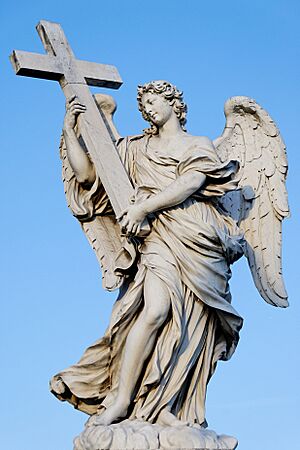Ercole Ferrata facts for kids
Ercole Ferrata (born 1610, died 1686) was a famous Italian sculptor. He worked during the Baroque period in Rome.
Contents
Life and Art of Ercole Ferrata
Ercole Ferrata was born in a town called Pellio Inferiore, near Como, Italy. He started his art training with a sculptor named Alessandro Algardi. Ercole became one of Algardi's best helpers. After Algardi passed away, Ercole and another student, Domenico Guidi, finished one of Algardi's artworks. This piece was called Vision of Saint Nicholas and was for a church in Rome. The way the figures were arranged in this sculpture was very new and came from Algardi's first ideas.
Developing His Style
At first, Ferrata's sculptures looked a lot like his teacher Algardi's work. Algardi's style was calm and classical. But Ferrata soon started to change his style. He began to create art that showed more feelings and drama. This new style was inspired by another very famous sculptor, Gian Lorenzo Bernini.
Ferrata is well-known for two sculptures in the Sant'Agnese in Agone church in Rome. One is The Death of St. Agnes, made between 1660 and 1664. This piece clearly shows Bernini's influence. The other is a marble relief called Stoning of St Emerenziana, made in 1660. This one still has some of Algardi's calm style. The top part of this relief was finished later by one of Ferrata's students, Leonardo Retti.
Under Bernini's guidance, Ferrata sculpted the Angel with a Cross for the Ponte Sant'Angelo bridge. He also helped finish the elephant statue that holds an obelisk in front of the Santa Maria sopra Minerva church. Earlier in his career, he worked in Naples with other sculptors. He also created the statue of Saint Catherine of Siena for a chapel in the Duomo di Siena. With Francesco Aprile, he sculpted Sant'Anastasia in a church in Rome. This statue looks similar to Bernini's famous Beata Ludovica Albertoni.
Teaching and Later Work
In 1673, a powerful leader named Cosimo III, Grand Duke of Tuscany, started an art school in Rome. He wanted promising students to learn by studying ancient sculptures. He put Ercole Ferrata in charge of this school, along with a painter named Ciro Ferri.
Ferrata was known for being an expert on ancient art. He even helped restore old sculptures. For example, when a headless statue was found, Ferrata added new parts to it. He created the Faun Carrying a Kid from this old torso. He also made the elegant arms for the famous Venus de' Medici statue.
Ferrata worked with Bernini on a beautiful fountain for a palace garden in Lisbon, Portugal. Sadly, this fountain was lost during a big earthquake in 1755.
Training New Sculptors
Ercole Ferrata had one of the most successful art studios for training new sculptors. Many talented artists learned from him. Some of his students included Giovanni Battista Foggini, Melchiorre Cafà, Leonardo Retti, Francesco Aprile, Michele Maglia, Filippo Carcani, Giuseppe Mazzuoli, Lorenzo Ottoni, and Giuseppe Rusnati. One of his last students was Camillo Rusconi, who joined Ferrata's studio in 1686.
Ercole Ferrata passed away in Rome in 1686.
Where to See His Art
You can find Ercole Ferrata's sculptures in many museums around the world. Some places where his work is kept include:
- The Museo d'Arte Sacra di Scaria
- The Birmingham Museums Trust
- The Wignacourt Museum
- The Victoria and Albert Museum
- The University of Michigan Museum of Art
- The Walters Art Museum
- The Princeton University Art Museum
Gallery
See also
 In Spanish: Ercole Ferrata para niños
In Spanish: Ercole Ferrata para niños







